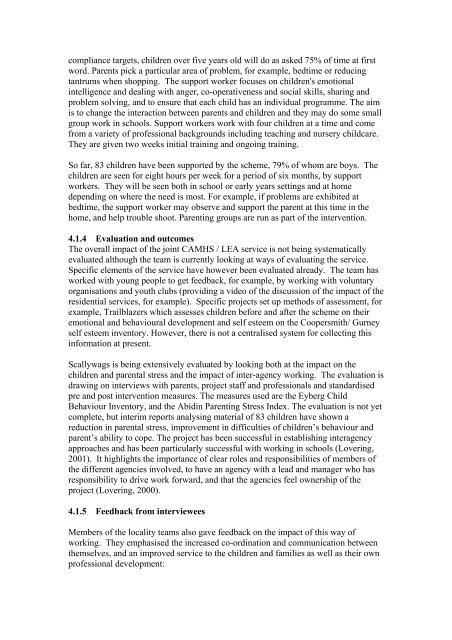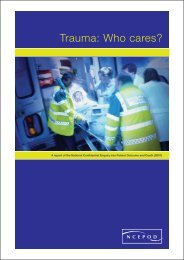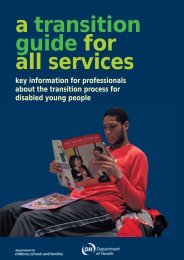(CAMHS) and Schools - London Health Programmes
(CAMHS) and Schools - London Health Programmes
(CAMHS) and Schools - London Health Programmes
You also want an ePaper? Increase the reach of your titles
YUMPU automatically turns print PDFs into web optimized ePapers that Google loves.
compliance targets, children over five years old will do as asked 75% of time at first<br />
word. Parents pick a particular area of problem, for example, bedtime or reducing<br />
tantrums when shopping. The support worker focuses on children's emotional<br />
intelligence <strong>and</strong> dealing with anger, co-operativeness <strong>and</strong> social skills, sharing <strong>and</strong><br />
problem solving, <strong>and</strong> to ensure that each child has an individual programme. The aim<br />
is to change the interaction between parents <strong>and</strong> children <strong>and</strong> they may do some small<br />
group work in schools. Support workers work with four children at a time <strong>and</strong> come<br />
from a variety of professional backgrounds including teaching <strong>and</strong> nursery childcare.<br />
They are given two weeks initial training <strong>and</strong> ongoing training.<br />
So far, 83 children have been supported by the scheme, 79% of whom are boys. The<br />
children are seen for eight hours per week for a period of six months, by support<br />
workers. They will be seen both in school or early years settings <strong>and</strong> at home<br />
depending on where the need is most. For example, if problems are exhibited at<br />
bedtime, the support worker may observe <strong>and</strong> support the parent at this time in the<br />
home, <strong>and</strong> help trouble shoot. Parenting groups are run as part of the intervention.<br />
4.1.4 Evaluation <strong>and</strong> outcomes<br />
The overall impact of the joint <strong>CAMHS</strong> / LEA service is not being systematically<br />
evaluated although the team is currently looking at ways of evaluating the service.<br />
Specific elements of the service have however been evaluated already. The team has<br />
worked with young people to get feedback, for example, by working with voluntary<br />
organisations <strong>and</strong> youth clubs (providing a video of the discussion of the impact of the<br />
residential services, for example). Specific projects set up methods of assessment, for<br />
example, Trailblazers which assesses children before <strong>and</strong> after the scheme on their<br />
emotional <strong>and</strong> behavioural development <strong>and</strong> self esteem on the Coopersmith/ Gurney<br />
self esteem inventory. However, there is not a centralised system for collecting this<br />
information at present.<br />
Scallywags is being extensively evaluated by looking both at the impact on the<br />
children <strong>and</strong> parental stress <strong>and</strong> the impact of inter-agency working. The evaluation is<br />
drawing on interviews with parents, project staff <strong>and</strong> professionals <strong>and</strong> st<strong>and</strong>ardised<br />
pre <strong>and</strong> post intervention measures. The measures used are the Eyberg Child<br />
Behaviour Inventory, <strong>and</strong> the Abidin Parenting Stress Index. The evaluation is not yet<br />
complete, but interim reports analysing material of 83 children have shown a<br />
reduction in parental stress, improvement in difficulties of children’s behaviour <strong>and</strong><br />
parent’s ability to cope. The project has been successful in establishing interagency<br />
approaches <strong>and</strong> has been particularly successful with working in schools (Lovering,<br />
2001). It highlights the importance of clear roles <strong>and</strong> responsibilities of members of<br />
the different agencies involved, to have an agency with a lead <strong>and</strong> manager who has<br />
responsibility to drive work forward, <strong>and</strong> that the agencies feel ownership of the<br />
project (Lovering, 2000).<br />
4.1.5 Feedback from interviewees<br />
Members of the locality teams also gave feedback on the impact of this way of<br />
working. They emphasised the increased co-ordination <strong>and</strong> communication between<br />
themselves, <strong>and</strong> an improved service to the children <strong>and</strong> families as well as their own<br />
professional development:

















